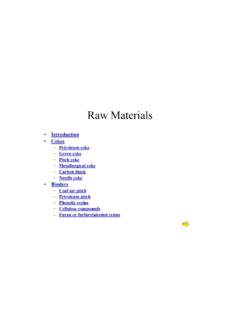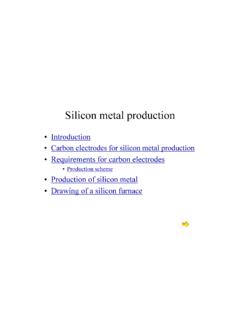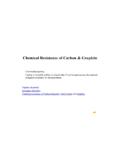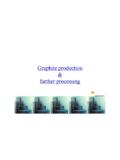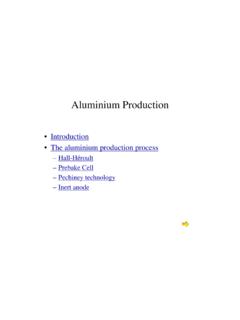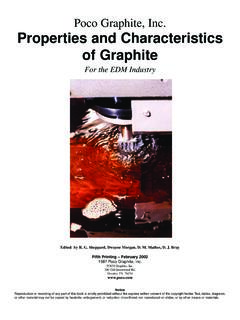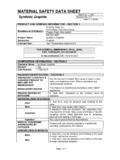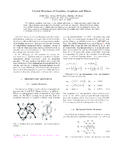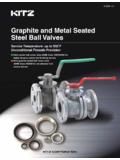Transcription of THE ELEMENT C - European Carbon and Graphite …
1 THE ELEMENT C Introductiongraphiteand Carbon Lattice Classification of grain size Fine-grained Graphite Coarse-grained Graphite Propertiesof Graphite and Carbon High temperature propertiesIntroduction Graphite and diamond are the two naturally occurring forms of the ELEMENT Carbon (C) and are mined. Graphite , as natural Graphite , was already known in the old ages as a mineral with a typical crystalline structure. Graphite obtained technical importance only a hundred years ago, when successfully produced synthetic Graphite in large dimensions and shapes. US-patent 542 982 from December 17, 1895 describes the graphitisation of Carbon material in an electrically heated resistance furnace.
2 This so-called electro Graphite gained increasing use in the, at that time, still young electric industry as current-conducting electrodes due to its excellent electric conductivity. Graphite can be manufactured from almost any organic material that leaves a high Carbon reside when heated in the absence of air. Graphite can come as fine-grainedor coarse-grained material. The theoretical density of mono crystalline Graphite is 2,26 g/cm3. Graphite has a hexagonal layer latticestructure. Graphite is a material which has mechanical propertiescose to ceramics. Its propertiesare excellent thermal stability, chemical resistance and high electrical conductivity.
3 It is thus widely used in the field of electro-metallurgy. The particle size of the solids used for production plays an important role as it strongly influences thefinal Graphite has been employed in chemical process equipment construction for more than 60 years. In this sector, its applicationsare determined in the first place by its chemical and physical properties and in the second place by its suitability as a material of construction for properties of Graphite materialsLattice Both natural and electro- Graphite have a hexagonal layer lattice. Its more or less perfect formation in the electro Graphite depends largely on the degree of crystalline order of the solid particles and the primary products obtained upon carbonising the carbonaceous binder materials used for its manufacture.
4 The particle size of the solids used plays an important role as it strongly influences the final properties. Graphite Lattice Formation800 C1200 C1400 C2200 C>2400 CCalciningPuffingGraphitizationS&NHexago nal Graphite release (abab)c/2 3,44 -3,354 Lc 400 -600 La 800 -1100 H. Marsh, 1991 Classification of grain size Fine-grained GraphiteFine-grained particles are produced by milling from coarse-grained raw material. Within the wide field of Carbon ceramics, the technology of fine-grained Carbon and Graphite was developed. This proved to be in many respects an independent manufacturing technique. The materials thus obtained are called fine-grained Graphite .
5 Their grain size distribution ranges from 1 mm to mm. Quite a number of combined properties, especially in small-sized shapes, can only be obtained by using fine-grained solids, being the lower end of coarse-grain material down to dust particles in the sub-micron range. Coarse-grained GraphiteCoarse-grained Graphite has a maximum grain size less than 25 mm. Nearly all of these grades are manufactured by extrusion. The processing of a lump or coarse-grain solid, as it is received as shipment, is economically of grain sizeClassification of fine grain size(based on size measuring techniques of the initial raw measuring techniques involved are not applicable to the finished product).
6 Semiconductor Graphite CB-4-1989, National Electrical Manufacturers Association, Washington,Decision , 1989 Graphite material can be classified by grain size as follows: Ultrafine (or micrograin Graphite ) Less than 10 microns maximum grain size Superfine Between 10 and 50 microns maximum grain size Fine Greater than 50 but less than or equal to 100 micron maximum grain size Medium Greater than 100 microns maximum grain size Properties of industrial Graphite Good electrical conductivity: the temperature coefficient of electrical resistance of Graphite is negative in a certain range of temperature, unlike that of metals. Near absolute zero, Graphite has only a few free electrons and acts as an temperature rises, electrical conductivity increases Good thermal conductivity: outstanding heat transfer properties Uniquemechanical strength: the tensile, compressive and flexural strength of Graphite increases as temperature increases to 2700 K.
7 At 2700 K graphitehas about double the strength it has when at room temperature. Above this temperatureits strength falls (see graph). Low coefficient of thermal expansion High thermal shock resistance: rapid heating or cooling is not aproblem Graphite is not wetted by molten glass or by most molten metals Low coefficient for friction High chemical resistance Corrosion resistance: oxidation resistance in air up to 500 C Low capture cross-section for of industrial Graphite Problem-free machining with standard machine tools: Graphite can be machined easily. Complicated parts with close tolerances can be machined with precision. Reasonable cheap material in comparison to other material with similar corrosion resistance Graphite does not melt but sublimes at about 3900 K.
8 In air, Graphite is resistant to oxidation up to temperatures of about 750 K. Graphite displays extremely low creep at room temperature, its flow characteristics being comparable to those of concrete. Creep in Graphite is strongly dependent on the grain orientation (creep is defined as plastic flow under constant stress).Baked Carbon Baked carbonBaked Carbon is a product manufactured from pitch, Carbon black or other raw materials and binders and has a similar hexagonal layer lattice structureto Graphite , but this is a less perfect properties of Carbon materialsPropertiesHigh temperature properties Electrical resistivity CTE CTEdelta CTE Thermal conductivity Specific heat Strength Young s modulusfrom room temperatureup to > 2000 C All graphs are showing typical property trends.
9 Absolute valueswill vary accordingto raw materialsand Resistivity ER of Graphite : Relative Change vs. Temperature 7080901001101201301401500200400600800100 0120014001600180020002200240026002800300 0temperature / CER / % Example: Graphite Electrode (needle coke) CTECTE of Graphite vs. Temperature: Difference of CTE 20/200to CTE 20/ 0,000,501,001,502,002,500200400600800100 0120014001600180020002200240026002800 Temperature / C CTE / m/(K m)Example:CTE20/200 = 0,20 m/K*m CTE1000 = 1,09 m/K*mCTE20/1000 = (0,20 + 1,09) m/K*m 1,3 m/K*mCTECTE20/ of Graphite vs. Temperature 0,000,501,001,502,002,503,003,504,000200 4006008001000120014001600180020002200240 0260028003000temperature / CCTE20 / / m/(K m)Extruded Graphite , with grainCoarse grained extruded graphiteagainst grainThermal Conductivity of Graphite vs.
10 Temperature 0501001502002503003504000200400600800100 0120014001600180020002200240026002800300 0 Temperature / C / W / (K m) Graphite Electrode (needle coke) Graphite Nipple (needle coke)TCSpecific Heat pcof Graphite vs. Temperature 0,00,20,40,60,81,01,21,41,61,82,02,22,40 2004006008001000120014001600180020002200 2400260028003000 Temperature / Ccp/ J / (g K)Cp Mechanical Strength of Graphite : Relative Change vs. Temperature 1001201401601802002200200400600800100012 00140016001800200022002400260028003000 Temperature / C / %Example: Graphite ElectrodeYMYoung's Modulus YM of Graphite : Relative Change vs. Temperature 1001101201301401500200400600800100012001 40016001800200022002400260028003000tempe rature / CYM/ %Example: Graphite Electrode& Graphite Nippl

